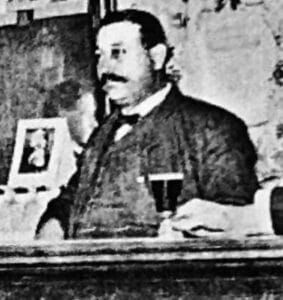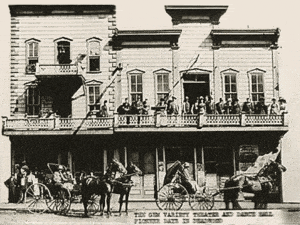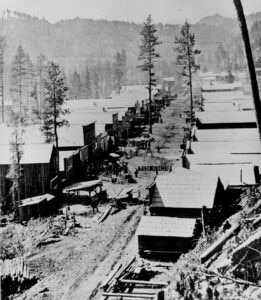“On the east side of Main Street…was constructed early in June a large, two-story frame building. This abominable institution…was later known far and wide as the “Gem Theater…” By reason of its drawing financial support from so many of the so-called leading citizens of the city, as well as from practically all residents and floaters of the underworld who drifted into the Hills at the time, it very soon won and held for many years, to the ever-lasting shame of Deadwood, the distinction of being the city’s chief attraction…Notwithstanding that churches and theaters had sprung up early in the new town and were daily well supported, the old “Gem Theater” outstripped them all and flourished, probably far beyond the wildest dreams of its dissolute and degraded promoter, Al Swearengen.”
That description comes to us courtesy of John S. McClintock, one of Deadwood’s earliest pioneers who later wrote a detailed account of his years spent in the infamous frontier town. He provided us with a first-hand glimpse into the sordid, shameful, and savage happenings that occurred in Deadwood during its early history, and, suffice to say, that McClintock was not a fan of Al Swearengen, Deadwood’s most infamous resident.

Early Years
Al Swearengen, also spelled Swearingen, was born Ellis Alfred Swearengen in Oskaloosa, Iowa, on July 8, 1845. He had a twin brother named Lemual and they were the oldest of eight children to Daniel J. Swearengen and Keziah Montgomery, a farming couple who would later move to the Dakota Territory and establish a thriving walnut grove near Yankton.
There is little information on Al Swearengen’s early years. On most of his life, in fact, before he showed up in Deadwood. Records show us that he left Iowa as a young man. By the time of the 1870 census, he was gone, but between Iowa and Dakota, he might have spent some time in Chicago, Illinois. That may be where he met and married his first wife, Nettie, who later divorced him soon after they arrived in the Black Hills, citing physical abuse and infidelity. As did his second and third wives, for that matter, because although it doesn’t seem like the real Al Swearengen was as murdery as his TV show counterpart, he was undoubtedly still a violent and cruel man who made most of his money by exploiting others, particularly women.
Swearengen arrived in the Dakota Territory during the Black Hills Gold Rush of the mid-1870s. However, he never intended to do any mining or prospecting. He preferred to let others do the hard work. Swearengen was of the correct opinion that people with money burning a hole in their pocket would be looking for places where to spend it, and he wanted to be the one providing them with all the booze, gambling, shows, and prostitution that they could handle.
However, before he became the proprietor of that den of iniquity known as the Gem Theater, it seems that Al Swearengen first tried his luck in Custer City. According to reports, he built a saloon there in 1875, offered a nice selection of liquor and gambling, and had over a dozen dance hall girls on staff who would do a lot more than dancing if the price was right. But for whatever reason, Swearengen decided that Custer City wasn’t the right fit for him. Maybe his saloon went bust, maybe there was trouble that ran him out of town, or maybe he simply saw more promise elsewhere. Whatever the reason might have been, Al Swearengen packed up his bags and moved to an up-and-coming mining town called Deadwood.
The Gem Opens

Swearengen arrived in Deadwood in 1876, during the late spring, and opened a small saloon he called The Cricket on the corner of Wall and Main Street where he staged bare-knuckle boxing matches. But The Cricket was a narrow tavern that barely had room for a tiny boxing ring and Swearengen had much grander ambitions than that. So the following year he tore it down and constructed a much larger two-story building on the same site, that included a gambling parlor, stage, saloon, and dance hall. In April 1876, the Gem Variety Theater was open for business.
The Gem had its own house orchestra and staged a variety of theater acts including dances of all kinds, musicians, trapeze artists, trained animals, skaters, and acting troupes. But don’t get the wrong impression. No matter who was the headliner on the bill, the Gem was not a place where you could take the family for a night of wholesome entertainment. Despite its classy name and fancy window dressing, the Gem was still a brothel, first and foremost, and had multiple curtained cribs around the stage where the female employees would take their customers. Here is how McClintock tells it:
“The floor in front was provided with a bar on one side and with seats for waiting patrons and spectators on each side. The rear end of the long building was cut up into small rooms. It was here that [Swearengen] kept under strict surveillance his herd of so-called female employees, when in fact they were on the level of “white slaves”… [who] carried out their contracts so long as they were physically able to do so. The duties devolving on them were to dance the entire night or just as long as they could secure partners.
During the first few weeks it appeared that they were overstocked with partners, as there were many strangers coming in who were desirous of being able to say that they had once danced in a “hurdy-gurdy house.” There were also many others who were so exhilarated that they would hang on to their female partners all night, or so long as their pocket change held out. This was true, especially of the teamsters known as “bullwhackers.” Many of those festive souls would frequently, after unloading their freight, take their teams out to graze for the night and then hike back to the “Gem” to spend the night and also all of their available cash in one way or another under its roof…
This vicious institution, in its later years, was conducted principally as a theater and frequently procured some of the best talent found among traveling attractions. However, it continued to the end in maintaining its notorious record as a defiler of youth, a destroyer of home ties, and a veritable abomination.”
Life in Deadwood

At the peak of the Gem’s popularity, it is estimated that Swearengen was taking in around $35,000 a week, which is over $1 million in today’s money. A chunk of it went to his no-good henchmen and the staff of the saloon, but the lion’s share went straight into Swearengen’s pocket. Guess it’s not hard to make a killing when most of your employees are more like indentured servants. Swearengen’s preferred method of recruiting new women for his brothel was to trick young girls from poor families or immigrants who barely spoke English by promising them good work out on the frontier. This usually involved a position in a hotel or with a respectable family, but once these unfortunate women arrived in Deadwood, they discovered that a spot at the Gem was the only thing waiting for them.
They were usually too poor to return home on their own, and with no other prospects, they had no choice but to work for Swearengen. Since he controlled their wages, he not only kept a portion for himself but also made the women pay for food, lodging, doctor visits, and other services. Thus, they remained perpetually indebted to him—or, at least, until he decided he no longer needed them.
Violence was the order of the day at the Gem courtesy of Al Swearengen and his cohorts. And although Swearengen was charged multiple times with assault and battery, as well as nonpayment of taxes on a couple of occasions, he never got in any serious trouble for it thanks to his many connections and the popularity of his establishment. Even in later years, when Deadwood began shedding its reputation as a lawless land, Al Swearengen and his Gem Theater were still there to ensure that the town never became too clean or civilized. According to a popular Deadwood legend, Swearengen and his lawful counterpart and nemesis, Seth Bullock, who we’ve already covered here at Biographics, split Main Street in half and agreed to stick to their side of the town. Swearengen controlled the rough-and-tumble lower Main Street, which became known as the Badlands. Here is McClintock again:
“Swearengen kept at all times a full crew of understrappers, with Dan Dority as general manager and Johnny Burns as floor manager, and several burly “bouncers” whose duties were to see to it that those who had spent their money, kept quiet or hit the sidewalks. All of these underlings were of the same low grade of morals as their boss and each, like himself, had his “woman” with the sole privilege of “beating her up” at any and all times that suited his pleasure, which was no uncommon occurrence.
On one occasion as I was passing up the street, I heard a great clash of voices and a shot fired. I waited until others had rushed in and following them, I beheld a man lying on the floor with a bullet hole clear through his head back of his eyes. The woman “Trixie” had grabbed a pistol while he was beating her and turned the tables on him. A doctor came and ran a probe through his head. However, there were no brains, at least in that section of his skull…”
Unsurprisingly, when the Gem burned down in 1879, along with all of Downtown Deadwood, Swearengen rebuilt his cashcow within a month, even grander than before. Then, when it happened again in 1894, he rebuilt it for a second time. But not for a third. When the Gem burned down once more in 1899, Swearengen decided that he’d had enough of Deadwood. The boom years of the gold rush were long gone and Deadwood itself was no longer the thriving, lawless town that welcomed the likes of Al Swearengen. Its population had dwindled to just a few thousand people, so Swearengen left Deadwood and sought greener pastures elsewhere.
A Murder Mystery?
Like Swearengen’s movements before he reached Deadwood, his final years after leaving are poorly documented. For a long time, it was reported that he became destitute after losing the Gem and died penniless just a few years later while trying to hop a freight train. This was the story for almost a century until his rediscovered mortuary records raised some questions that suggested a more sinister and, frankly, a more fitting end for a man like Al Swearengen.
According to the coroner’s inquest, Swearengen’s body was found in Denver in November 1904, by the Denver & Rio Grande railroad crossing. His cause of death was a nasty skull fracture but he also had broken ribs and crushed legs. His injuries were consistent with a fall from a train, but they could have also come from a serious beating.
That’s about all the hard facts we have, now time for some speculation. It seems that Al Swearengen really did lose all of his money. Karma in action, presumably. Denver newspapers reported that he spent the last few years of his life working as a prospector and farmhand, and he had a recent arrest for vagrancy at the time of his death. This might sound a bit implausible at first, but remember that the height of the Black Hills gold rush occurred during the mid-1870s. The Deadwood Swearengen left behind was not the same boomtown from decades earlier where he was raking in thousands of dollars every night. It’s probably why he didn’t rebuild the Gem after it burned down a third time – he simply couldn’t afford it.
It seems that, while in Denver, Swearengen went by Albert Ellis. Probably a good idea given how many enemies he made in his lifetime, but it might not have been enough. Remember that we said Al had a twin brother named Lemual? Well, a month before Swearengen’s death, Lemual was attacked by an unidentified assailant who shot him five times. He didn’t rob him or anything like that; just shot him and left him for dead, although Lemual somehow survived his ordeal.
Twin brothers suffering violence within a month of each other is cause for suspicion, which is why many believe that Al Swearengen was beaten to death and Lemual was just an unfortunate case of mistaken identity. And when five gunshots didn’t do the trick the first time, the attacker went beast mode with a bat or a lead pipe or something the second time around.
So what do you think? Was Al Swearengen’s death an accident or did someone finally even the score with the man who was once the terror of Deadwood?



